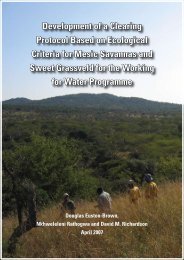Metsi Consultants - DWA Home Page
Metsi Consultants - DWA Home Page
Metsi Consultants - DWA Home Page
Create successful ePaper yourself
Turn your PDF publications into a flip-book with our unique Google optimized e-Paper software.
Report No 678-F-001<br />
METSI CONSULTANTS: SUMMARY OF MAIN FINDINGS FOR PHASE 1 DEVELOPMENT<br />
The costs of mitigation for public and animal health are relatively low in comparison to compensation costs for<br />
resource losses and the differences between scenarios are not as marked (Table 10.6). This stems from the<br />
nature of the mitigation, i.e., immunisation and sanitation measures are directed at communities and not directly<br />
at the specific consequences of flow changes.<br />
Fish<br />
Forage<br />
Medicinal plants<br />
Wild vegetables<br />
Trees & shrubs<br />
0 2 4 6 8 10 12 14 16<br />
Minimum Degradation Design Limitation Fourth Treaty<br />
Figure 10.2 Percentage of total resource value lost for each scenario.<br />
The relationship between extracted water yields from the system and the extent of resource losses is not linear<br />
over the ranges measured in the study. While the Treaty Scenario extracts only 20% more water from the system<br />
than the Design Limitation one (which utilizes outflow capacities to the maximum extent to avoid downstream<br />
impacts), overall resource losses are 30% higher and fish and forage losses about 50% higher. Losses under the<br />
Treaty Scenario are also substantially higher than under a scenario in which relatively small additional<br />
downstream flows are allocated, e.g., overall estimated resource losses for the Treaty Scenario are 17% higher<br />
than under the Fourth Scenario, whereas the additional water yield is only ~8% more. The implication is that, in<br />
seeking to mitigate environmental impacts and reduce resource losses, the differences between the Treaty and<br />
other scenarios will indicate opportunities for achieving this without necessarily sacrificing large amounts of water<br />
yield.<br />
10.10. OPTIMISATION OF TREATY MINIMUM RELEASES<br />
Article 7(9) of the Treaty refers to water released to rivers downstream of the LHWP structures, and states “The<br />
LHDA shall at all times maintain rates of flow in the natural river channels immediately downstream of the Katse<br />
and Mohale dams of not less than 500 and 300 litres per second respectively and shall, if so required, release the<br />
quantities of water from either Katse or Mohale reservoirs as the case may be, necessary to maintain such rates<br />
of flow: provided that subsequent to the implementation of Phase 2 of the Project, such rates of flow may be<br />
adjusted by agreement between the Parties and provided further that in the event of either reservoir being at its<br />
minimum operating level, the quantities of water released shall be equal to the flow rate into such reservoir not in<br />
excess of the specified rate of release.”<br />
If the Treaty provisions are interpreted strictly as stated above, then minimum releases of 0.5 and 0.3 m 3 s -1 would<br />
be required at all times from Katse and Mohale, respectively, and there would be no opportunity to optimise the<br />
releases (which implies changing them to suit downstream conditions). If, however, the Treaty-specified releases<br />
57

















